Lately I’ve been having a lot of conversations around investment terms with searchers, as well as investors.
About 15 years ago, I interned at a search fund. And, over the last few years, I’ve started to invest in the asset class going direct as well as through funds of search funds.
Investing in search funds is a great way to scratch my entrepreneurial itch, extremely rewarding when a searcher finds success, and can be economically rewarding too.
This post is my attempt to share thoughts on self funded search economics in an effort to contribute to the search fund community, get feedback on my thinking from a wider audience, and of course meet more people who are doing searches/investing and may want to collaborate (please feel free to reach out!).
You can watch a video of me explaining this model here, and download the excel here:

Enterprise Value
The standard finance equation is enterprise value = debt + stock – cash. Enterprise value is how much the company itself is worth. Many times people confuse it with how much the stock is worth and find the “minus cash” part of this really confusing.
So, you can rearrange this equation to make it stock = enterprise value – debt + cash. Make more sense now?
Enterprise value is just how much you’re willing to pay for the company (future cash flows, intellectual property, etc), not the balance sheet (debt and cash).
Most investors and searchers think about the EBITDA multiple of a company on an enterprise value basis because they’ll be buying it on a cash free, debt free basis. It becomes second nature to think about EBITDA multiples and know where a given business should fall given scale, industry, etc.
However, I believe this second nature way of thinking of things can be a massive disadvantage to investors given the way EV and multiples are talked about in our community currently.
Sources of capital, the typical way to calculate enterprise value for self funded searchers
If you’ve ever looked at or put together a teaser for a self funded search deal, you will notice that the deal value is equal to the sum of the sources of capital minus deal fees and cash to the balance sheet.
As a simple example, if there is $4 mm of debt to fund the deal, $1 mm of equity, and $200k of deal fees, the enterprise value = $4 mm + $1 mm – 200k = $4.8 mm.
We’ll use slightly more complex numbers in our example: If a searcher is taking a $3.2 mm SBA loan, $850k seller note, putting in $120k themselves, getting $350k of equity from the seller, a $500k earnout, and $1.2 mm of equity financing minus $350k to the balance sheet and $250k of deal fees, then the enterprise value will be $5.62 mm.
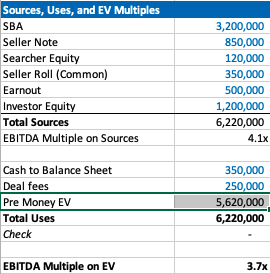
Our example company has $1.5 mm of EBITDA, so the EBITDA multiple is 3.7x. This is a pretty attractive acquisition multiple for a business that meets traditional search criteria (recurring revenues, fragmented competition, high gross margins, low customer concentration, etc).
If you’re seeing a search fund deal for the first time, the headline of “we’re buying a decent company for 3.7x, and replacing a tired owner with a hungry operator” is pretty exciting!
However, if you’re an investor, there is some nuance to this enterprise value number and the true EBITDA multiple you are investing in.
The trick with self funded enterprise value
The security that most self funded search investors get in a deal is participating preferred stock with a paid in kind dividend. This means when there’s an exit, you get your money back before any other equity holder, then get a certain percent of the business, and whatever dividend you’ve been owed in the interim accrues to your principle.
It’s a really favorable security for the investor, and one that is basically impossible to get in VC where straight preferred stock is much more common (no pun intended).
The key terms are what percent of common equity does this security convert into after the originally principal is paid back, and what is the dividend.
The share of common equity the investor group will get typically ranges from 10-50% of the total common stock. The dividend rate is usually 3-15%. The average I’m seeing now is around 30% and 10% for common and dividends respectively.
The strange this about the enterprise value quoted to investors in a teaser/CIM is that it doesn’t change as the percent of common changes, even though this has large implications for how much the common equity is worth and the value investors receive.
For example, I may get a teaser where the sources of investment – cash to balance sheet – deal fees = $3.7 mm for a $1 mm EBITDA company, which would imply a 3.7X EBITDA multiple. Let’s say the searcher is offering investors 30% of the common and a 10% dividend.
Let’s now say that the searcher is having a tough time raising capital and changes their terms to 35% of common and a 12% dividend. Does the effective enterprise value change for investors? I would argue yes, but I would be surprised to see it changed in the CIM/teaser.
This isn’t a knock on searchers or the search fund community. It’s just kind of how things are done, and I think this is mostly because it’s really hard to think about how the enterprise value has changed in this scenario.
However, the natural way of using EBITDA multiples to think about value for a business that is so common in PE/SMB can be extremely misleading for investors here. You may be thinking 3.7X for this type of business is a great deal! But, what if the security you’re buying gets 5% of the common?
If you’re in our world, you may counter this point by saying most searchers will also supply a projected IRR for investors in their CIM. However, IRR is extremely sensitive to growth rate, margin expansion, and terminal value. While the attractiveness of the security will be reflected, it can be greatly overshadowed by lofty expectations.
To get more clarity and have a slightly different mental model on the effective price investors are paying for this business, let’s go back to basics. Enterprise value should be debt + preferred stock + common stock – cash.
We know the values of each of these numbers, except the common. So, the main question here becomes: how much is the common equity worth?
Calculating value of common equity for self funded search funds
Equity value for most search fund deals = preferred equity from investors + the common equity set aside for the searcher and sometimes also advisors, board, seller.
We know that the preferred equity is investing a certain amount for a certain amount of common equity. The rub is that they are also getting a preference that they can take out before any common equity gets proceeds, and they are getting a dividend.
So, the exercise of valuing the common equity comes down to valuing the preference and dividend.
In my mind, there are three approaches:
- The discount rate method where you take the cash flows you’ll get in the future from the pref/dividends and discount them back at the discount rate of your choice. I am using 30% in my model which I believe accurately compensates investors for the risks they are taking in a small, highly leveraged investment run by an unproven operator. If you believe in efficient markets, this number also fits as it mirrors the historical equity returns as reported by the Stanford report, with a slight discount given this asset class has clearly generated excess returns relative to other assets on a risk adjusted basis, hence interest in these opportunities from an expanding universe of investors.
- The second method is to calculate how much money you’d get from your preference and dividends, taking into account that per the Stanford study around 75% of search funds will be able to pay these sums, and then discount these cash flows back at a rate more in line with public equities (7% in my model). This yields a much higher value to the preference/dividend combo, and therefore lowers the implied value of the common equity.
- The last method is to just say nope, there is no value to the preference and dividend. I need them and require them as an investor, but they are a deal breaker for me if they aren’t there, and therefore they don’t exist in my math. This of course makes no logical sense (you need them, but they also have no value?), but I’ve left it in as I think many investors probably actually think this way and it creates a nice upper bound on the enterprise value. Side note, as with obstinate sellers, jerk investors are usually best avoided.
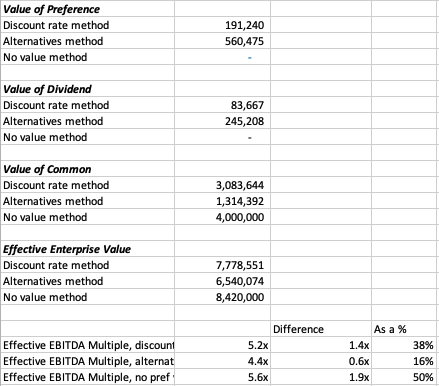
In our example, you can see a breakdown of the preference value, dividend value, and therefore common value and enterprise value for this deal.
In each case, the effective EBITDA multiple moves from 3.7x to something much higher (see the last 3 lines).
There are some simplifying assumptions in the model (no accruing dividend, all paid in last year), and some weird stuff that can happen (if you make the hold time long and the dividend greater than the 7% equity discount rate, the value of the dividend can get really big).
These flaws aside, I think this creates a nice framework to think through what the common is actually worth at close, and therefore what enterprise value investors will be paying in actuality.
It’s worth noting that the whole point of this is to benchmark the value you’re getting relative to market transactions in order to understand where you want to deploy your capital.
This creates a method to translate cash flow or EBITDA multiples of other opportunities on an apples to apples basis (if only there were a magical way to translate the risk associated with each as well!).
Another note, we could calculate the value of the common to be what this asset would trade at market today in a well run auction process minus any obligations (debt, preference, seller financing). However, I think that understates the option value inherent in this equity, a value that is only realized when a new manager takes over with more energy and know how.
There is a finance nerd rational for this. If you plot the value of equity in a leveraged company on a chart, it mirrors the payout of a call option. In both cases, the value of the security increases at a certain inflection point: when the value of equity rises above the strike price in an option, and when the enterprise value of a company rises above the debt level in a levered company.
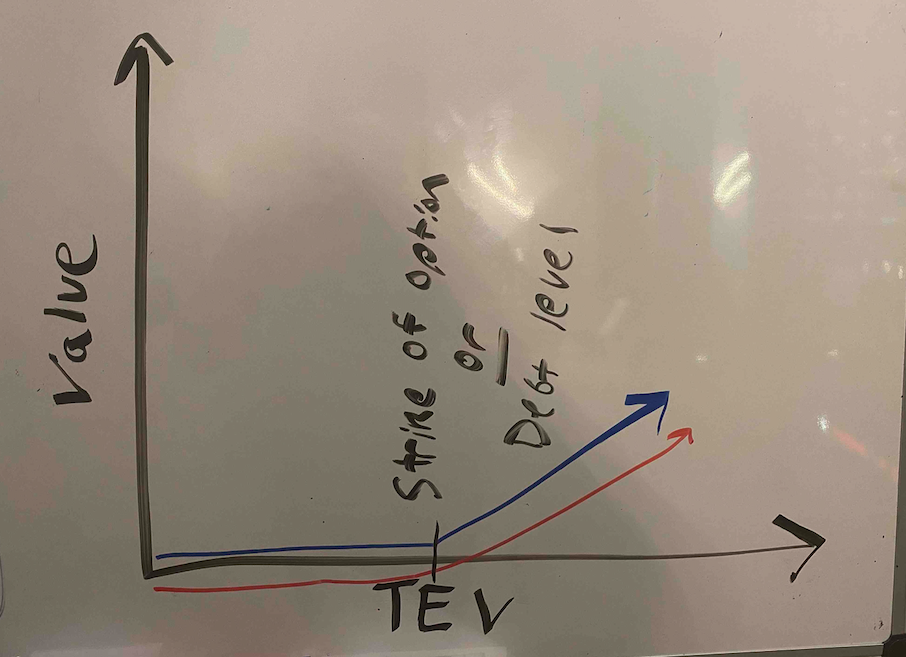
The common equity of a highly levered company can therefore be valued by a similar methodology as the call option: Black Scholes. If you remember back to finance class, increasing volatility will increase the value of an option.
In the search fund case, we’ve (hopefully) increased the (upside) volatility and therefore create more value than simply selling the company today.
A few more thoughts on investor economics
There are a few other ways to think about the economics you get as an investor to best understand if this is the deal for you.
First, you may want to think about how much your investment will be worth day 1. The key lever in this model is what discount this company is being bought for relative to fair market value. For example, the searcher may have proprietary sourced a great company and is buying it for 25% below what it would trade at in a brokered auction.
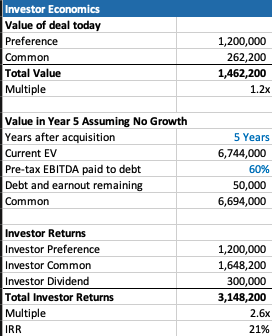
This is very much a “margin of safety” philosophy on things. Same with the calculation on how much you’ll receive in year 5 (after QSBS hits) assuming no growth in the business.
The only problem with each of these calculations is that they never play out in practice. Most companies don’t just stay the same, you’re either in a rising tide or you’re in trouble. And, you’re almost never going to sell in year 1, and definitely not for a slight premium to what it was bought for.
However, if your investment is worth 30% higher day one, and you can make a 20% IRR assuming nothing too crazy happens either way in the business, that’s not a bad place to start. Add in a strong searcher, decent market, some luck, and you’re off to the races.
Thoughts on searcher economics
A lot of this post has considered things from the investor perspective as my main quandary was related to how to create an EBITDA multiple that made sense for investors.
However, the point of this post is not to say searchers are misrepresenting or being unrealistic with their terms. In fact, I think it’s quite logical that self funded searchers capture the massive economic value that they do.
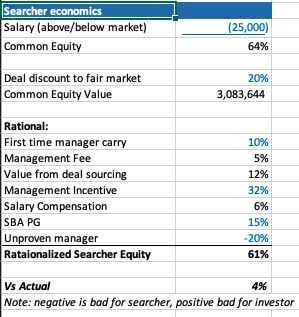
There are many reasons why self funded searchers deserve the lion share of the common equity.
First, they are providing a nice service of giving investors a positive expected value home to park their money with much lower correlation to the market than other asset classes ($1 mm EBITDA companies don’t see lots of multiple contraction/expansion throughout cycles).
Most money managers that fit that criteria are taking a 2/20, of course they also usually have a track record. So, I’ve used a 10% carry in my model, but stuck to 2% annual management fee.
The searcher spent a lot of time, and probably money, finding this company. That’s a lot of value, especially if it’s a below market price. They should be able to capture a lot of the value in finding a below market deal.
The searcher may be taking a below market salary, and needs to get comped like any CEO, with stock options. In my example model I have $1 mm of stock vesting over the hold period, as well as extra comp for taking a below market salary.
Searchers are also usually putting their financial standing at risk by taking a personal guarantee on the bank/SBA loan. This is really tough to put a number on, as is the last line in my framework where searchers are dinged for lack of experience. Like any good model, you need a few lines that you can fudge to make the math work 🙂
What you do think?
I’m shocked that I wrote all this. I was going to type a few paragraphs and a quick excel. However, putting this to paper has been a great exercise for me to sharpen my thinking.
Now I’d like you to help me further. Where do you think this should be changed in this framework? How do you think about things from the investor and/or searcher side?
Feel free to shoot me a note if you have thoughts (even just to tell me I’m being way too academic with this, which I actually agree with).
Lastly, a post like this is really a trap I’m putting on the internet to catch any like minded people in so that we can figure out ways to collaborate now or in the future. So, at the very least, connect with me on LinkedIn 🙂

Hello! I’m at work browsing your blog from my new iphone!
Just wanted to say I love reading through your blog and look forward to all your posts!
Keep up the fantastic work!
This paragraph is genuinely a nice one it helps new web visitors, who
are wishing in favor of blogging.
Why users still use to read news papers when in this technological globe all is available on web?
Howdy I am so happy I found your blog, I really found you by accident, while I was browsing on Digg for something else,
Anyways I am here now and would just like to
say thank you for a tremendous post and a all round exciting blog (I
also love the theme/design), I don’t have time to browse it all at the minute but I
have book-marked it and also included your RSS feeds, so when I have time I will be back to read a great deal more, Please do
keep up the fantastic b.
Great post. I am experiencing a few of these issues as well..
Wow, that’s what I was seeking for, what a information! existing here at this webpage,
thanks admin of this web page.
I was very pleased to discover this site. I want to to thank you for ones time
just for this fantastic read!! I definitely really liked every
bit of it and I have you saved as a favorite to see new stuff
in your blog.
My family always say that I am wasting my time here
at web, except I know I am getting familiarity daily
by reading such pleasant articles or reviews.
Wow, awesome blog layout! How long have you been blogging for?
you made blogging look easy. The overall look of your web site is excellent, as well as the content!
Today, I went to the beach with my children. I found a
sea shell and gave it to my 4 year old daughter and said “You can hear the ocean if you put this to your ear.” She put the shell to her ear and screamed.
There was a hermit crab inside and it pinched her ear.
She never wants to go back! LoL I know this is totally off topic but I had
to tell someone!
My developer is trying to convince me to move to .net
from PHP. I have always disliked the idea because of the expenses.
But he’s tryiong none the less. I’ve been using Movable-type on various websites for about
a year and am nervous about switching to another platform.
I have heard very good things about blogengine.net. Is there a way I can import all my wordpress
posts into it? Any kind of help would be really appreciated!
Good web site you have got here.. It’s hard to find good
quality writing like yours nowadays. I seriously appreciate individuals like you!
Take care!!
You ought to take part in a contest for one of the greatest blogs on the net.
I will recommend this website!
Its like you read my mind! You appear to know so much about this, like you wrote
the book in it or something. I think that you could do
with a few pics to drive the message home a little bit, but instead of that, this is great blog.
A great read. I will definitely be back.
magnificent issues altogether, you simply won a new reader.
What might you recommend about your post that you just made some days in the past?
Any certain?
I know this site offers quality based articles or reviews and additional stuff, is there any other web site which presents such information in quality?
If you would like to grow your experience only keep visiting this site and be updated with the
most up-to-date news posted here.
I used to be suggested this website by means of my cousin. I am not positive whether this submit is written by him as nobody
else understand such specific about my difficulty. You
are wonderful! Thank you!
I am really loving the theme/design of your weblog. Do
you ever run into any web browser compatibility issues?
A handful of my blog readers have complained
about my website not working correctly in Explorer but looks great in Safari.
Do you have any recommendations to help fix this problem?
I think what you posted made a lot of sense.
But, what about this? what if you typed a catchier post title?
I mean, I don’t want to tell you how to run your
website, however what if you added a title that makes people
want more? I mean Thoughts on Search Fund Economics –
Phil Strazzulla's Blog is a little vanilla. You ought to
peek at Yahoo’s front page and note how they create article headlines to get
people to open the links. You might add a related video or a picture or two to grab readers excited about what you’ve got to say.
Just my opinion, it might make your blog a little livelier.
I really like your blog.. very nice colors & theme. Did you make
this website yourself or did you hire someone to do it for you?
Plz respond as I’m looking to construct my own blog and would like to find out where
u got this from. many thanks
Pretty section of content. I just stumbled upon your blog and in accession capital to assert that
I acquire actually enjoyed account your blog posts. Anyway
I will be subscribing to your augment and even I achievement you access consistently fast.
WOW just what I was looking for. Came here by searching for https://trade-britanica.trade/wiki/The_Stuff_About_Minecraft_Server_Hosting_You_Most_likely_Hadnt_Thought_of_And_Really_Should
Appreciation to my father who shared with me regarding this website,
this blog is in fact remarkable.
I am truly thankful to the owner of this web site who has shared
this fantastic article at here.
Incredible! This blog looks just like my old one!
It’s on a completely different topic but it has pretty much
the same layout and design. Outstanding choice of colors!
Hi there, i read your blog occasionally and
i own a similar one and i was just curious if you get a lot of spam
remarks? If so how do you protect against it, any plugin or anything you can suggest?
I get so much lately it’s driving me mad so any
help is very much appreciated.
I take pleasure in, lead to I discovered just what I used to
be having a look for. You’ve ended my four day long hunt!
God Bless you man. Have a nice day. Bye
Hello, I check your blog daily. Your story-telling style
is awesome, keep up the good work!
I think the admin of this web site is in fact working hard in favor of his web page, since
here every data is quality based data.
I am not sure where you’re getting your information, but good topic.
I needs to spend some time learning much more or understanding more.
Thanks for fantastic information I was looking for this info for my mission.
Your style is very unique compared to other folks I’ve read stuff from.
I appreciate you for posting when you’ve got the opportunity, Guess I will just book mark this
blog.
What a data of un-ambiguity and preserveness of precious know-how concerning unexpected emotions.
Greetings from Ohio! I’m bored to tears at work so I decided to check
out your website on my iphone during lunch break. I
love the knowledge you present here and can’t wait
to take a look when I get home. I’m surprised at how fast
your blog loaded on my phone .. I’m not even using WIFI, just 3G ..
Anyhow, awesome blog!
It’s nearly impossible to find experienced people in this particular topic, but you seem like you know what you’re talking about!
Thanks
WOW just what I was looking for. Came here by searching for discuss
I was recommended this blog by my cousin. I am not sure whether this post
is written by him as no one else know such detailed about my trouble.
You’re amazing! Thanks!
It’s the best time to make some plans for the future and it’s time to be
happy. I have read this post and if I could I wish to suggest you some interesting
things or suggestions. Maybe you could write next articles referring to
this article. I desire to read even more things about it!
I every time spent my half an hour to read this blog’s content everyday along with a mug
of coffee.
Hi, i think that i saw you visited my site thus i came to “return the favorâ€.I am trying to find things to enhance my website!I
suppose its ok to use some of your ideas!!
I am really happy to read this web site posts which contains lots of useful data, thanks for providing
such data.
Its like you read my mind! You seem to know so
much about this, like you wrote the book in it or something.
I think that you could do with a few pics to drive the message home
a little bit, but instead of that, this is wonderful blog.
An excellent read. I’ll definitely be back.
I’m impressed, I must say. Rarely do I come
across a blog that’s both educative and interesting,
and without a doubt, you have hit the nail on the head.
The issue is something that not enough people are speaking intelligently about.
I am very happy I came across this during my hunt for something
concerning this.
Pretty! This has been an extremely wonderful article.
Many thanks for providing these details.
Excellent post. I used to be checking constantly this blog
and I’m impressed! Very helpful info specially the
final part 🙂 I maintain such information much.
I was seeking this particular information for a very long time.
Thanks and best of luck.
My developer is trying to convince me to move to .net from
PHP. I have always disliked the idea because of the expenses.
But he’s tryiong none the less. I’ve been using Movable-type on numerous websites for about a year and am concerned about switching to another platform.
I have heard great things about blogengine.net.
Is there a way I can import all my wordpress posts into it?
Any kind of help would be greatly appreciated!
hello!,I really like your writing so much! proportion we be in contact extra about your article on AOL?
I need a specialist in this area to solve my problem.
May be that’s you! Having a look ahead to look you.
If you wish for to take a good deal from this article then you have to apply
these methods to your won webpage.
Thanks for sharing your thoughts on discuss. Regards
WOW just what I was looking for. Came here by searching for https://atavi.com/share/vdf720z189e6t